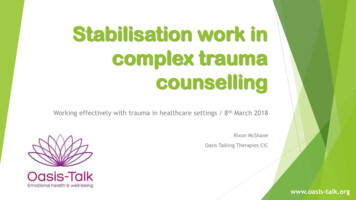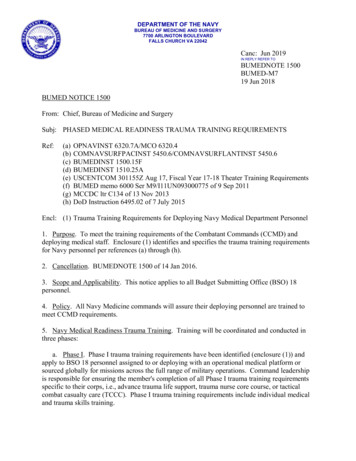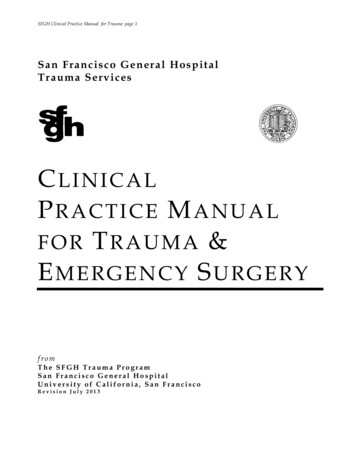
Transcription
Stabilisation work incomplex traumacounsellingWorking effectively with trauma in healthcare settings / 8th March 2018Rixon McShaneOasis Talking Therapies CICwww.oasis-talk.org
What is complex trauma? CPTSD was originally proposed in 1992 by Judith Herman in her book Trauma & Recovery. The most common exemplar is prolonged trauma of an interpersonal nature, particularly child sexual abuse orchildhood trauma and neglect more broadly. Courtious (2004) expanded complex trauma experiences to include “other types of catastrophic, deleterious,and entrapping traumatisation occurring in childhood and/or adulthood”. The unique trademark of complex trauma – compromise in the individuals' self-development, which occursduring a critical window of development in childhood, when self-definition and self-regulation are formed(Courtious and Ford, 2009). Herman and others have argued that the diagnosis of PTSD, as it is defined (mostly based on the prototypes ofcombat, disaster and rape) does not fit accurately enough. The category is not yet adopted by either the American Psychiatric Association's (APA) DSM-V, or in the WorldHealth Organization's (WHO) ICD-10. Current captured under the acronym DESNOS (Disorders of ExtremeStress Not Otherwise Specified). It is proposed for the ICD-11, to be finalized in 2018.www.oasis-talk.org
Symptoms of CPTSDThree core symptoms: (1) re-experiencing, (2) avoidance/numbing (3) hyper-arousalAlong with disturbances in ability to self-regulate across five domains:1.Difficulties emotional regulation including symptoms such as persistent dysphoria, chronic suicidalpreoccupation, self injury, explosive or extremely inhibited anger2.Alterations in attention and consciousness, including ruminative preoccupation and experiencingdissociation or depersonalisation.3.Changes in self-perception/ one’s system of meanings, such as a chronic and pervasive senseof helplessness, paralysis of initiative, shame, guilt, self-blame, a sense of defilement or stigma, and asense of being completely different from other human beings.4.Disturbance in relational capacities, such as not being able to trust, not being able to feel intimate withothers.5.Somatic distress and disorganisation accompanied by feelings of terror and confusion.www.oasis-talk.org
Resick, P.A et al (2012) A critical evaluation of the complex PTSD literature: implications for DSM-5www.oasis-talk.org
Working with trauma Sharing traumatic experiences can leave individuals vulnerable to becoming dysregulated and at timesre-traumatised. It is now the clinical consensus, that all trauma treatment must begin with an emphasis on safety andstabilisation. Babette Rothschild, author of the excellent ‘The Body Remembers’ (Rothschild 2000) argues thattrauma memories should not be addressed before the client is equipped to manage the distress. She uses the analogy of teaching a new driver to be really comfortable with the “braking” system in acar before “accelerating”. If we follow this principle not only will we make trauma therapy safer and easier to control but theindividual learns that they can touch just the surface of their experience and then return to a safe andneutral ground.www.oasis-talk.org
The challenge of complex trauma Complex PTSD often creates difficulties with emotional regulation Aggressive outbursts and self-destructive behaviours Extreme anxiety and agitation Inability to tolerate distress Rapid fluctuations in mood Inability to self-sooth Complex PTSD creates highly sensitivity to threat Propensity towards self-shaming/criticism/blame Emotional dysregulation and dissociation Interpersonal difficultieswww.oasis-talk.org
www.oasis-talk.org
Phased Treatment ApproachSafety, Stabilisationand 84% of 50 expert clinicians endorsed a phase-based or sequenced approach as first line of treatmentfor Complex PTSD (Journal of Traumatic Stress, 2011)www.oasis-talk.org
Key parts of stabilisation Learning how to regulate arousal and impulses Reflecting on inner experience and patterns of thinking and feeling Knowing how and when to apply the brakes Develop awareness of risk (including how and why individuals put themselves at risk) Practicing adaptive coping strategies for dealing with suicidal and self-harming impulses Discovering how to anticipate stressful or triggering events Learning how to calm body and mind Distinguishing between past and present reality and how to stay “in the present” Recognising and making better use of dissociative abilitieswww.oasis-talk.org
The foundations of stabilisation 1 The work of stabilisation begins with creating a ‘secure base’ and container. Fallot and Harris (2008) propose five essential conditions in creating a secure base in orthinesschoicecollaborationempowerment Clear contracting and transparency about the therapeutic process at the outset of therapy In complex trauma work this may require more structure and feedback then we are used to. Empathic listening, encouraging the client to take a lead, and careful attention to the client’s feelingscan actually be counterproductive at this stage of therapywww.oasis-talk.org
The foundations of stabilisation 2 A key part of stabilisation work is psychoeducation. The use of psychoeducation has two purposes at this stage of treatment:(1) it helps the client make sense of symptoms: how to recognise them; how to anticipate them, what they meanand how to manage them(2) it decreases the clients sense of shame, confusion, and a sense of being crazy We want to convey that all symptoms make perfect sense as a response to traumatic experience Each symptom represents either a deeply encoded memory or an attempt to solve a challenge or danger This approach can be empowering because it draws a picture of someone who is smart, creative, andresourceful Each troubling symptom can be re-framed with the appropriate psychoeducational input Stabilisation can minimize mechanisms that contribute to the rupturing of the therapeutic alliance andderailment of treatment.www.oasis-talk.org
Using Outcome measures to helpclients The DSM Criteria for PTSD can be very helpful because each and every troubling symptom can bereframed with the appropriate psychoeducational input Psychoeducation on symptoms also provide opportunity to talk about the role of questionnaires (e.g.PHQ9, GAD7, IES) Value the time clients spend completing questionnaires and explore how they can be used to monitorand track improvements across the course of therapywww.oasis-talk.org
Emotional awareness andregulation Learning to become aware of and validate emotions Labelling feelings, triggers, cognitions and typical coping responses Emotion regulations skills are built and capitalize on healthy coping strategies clients bring into treatment “Three channels of distress” (physiological/somatic, cognitive and behavioural) useful sense-making model Resistance toward experiencing feelings at all and/or experiencing positive emotions Psychoeducation on role of emotions in interpersonal functioning and decision making Sensitivity required but important step in becoming ‘unstuck’ and moving towards emotionally engage livingwww.oasis-talk.org
Pay attention to how clients putsthemselves at risk and why Many traumatised clients put themselves at risk in a number of ways for a number of reasons Habituated to danger Attachment cry Habitual dissociation in the face of threat It is important that we openly talk about safety and contract This can be surprising, disconcerting and confusing for clients Facilitate thinking about dis/advantages of un/safe behaviours Discuss levels of safety net Develop a safe plan as a reference point Therapist should not take responsibility for client safety but help build awarenesswww.oasis-talk.org
www.oasis-talk.org
Making sense of dissociation Outside flashbacks, it is important to understand the processes underpinning dissociative symptoms Dissociation remains ill-defined and embraces a collection of differing presentations related to the idea of dis-associating frominformation processing Providing information on the basis of dissociation helps clients who cannot otherwise understand their experience A spectrum of dissociation from non-pathological level through to highly dysfunctional states Defensive mechanism decreasing the awareness of the impact of trauma so that can better functioning in the short-term? Peri-traumatic dissociation is a compensatory mechanism to marked physiological arousal? 2 important distinctions - Detachment and Compartmentalization Within Compartmentalization we see Absorption e.g. a form of ‘tuning-in’ to a limited aspect of experience and a ‘tuning-outphenomenon that would include post-traumatic amnesias, and traumatic memories that lack emotion Compartmentalization can incorporate the two e.g. in DID we see tuning in to parts of self while detaching from other aspects ofself and in flashbacks we often see acute ‘tuning in’ to one aspect of an experience whilst being temporarily detached The models indicate necessary changes – if a client is detaching too much, we need to help them ‘tune in’; if they are ‘tuning in’excessively, then we need to learn to decentre, re-focus , or review This is crucial to flashback managementwww.oasis-talk.org
Know when to apply the brakes Knowing when to apply the brakes minimizes the risk of client’s feeling dysregulated Handled with sensitivity so that client’s never feel disrespected or misinterpret pacing as a minimisation of their feelings andexperience Pacing allows tracking and monitoring of intensity of emotions Process of temporarily slowing down allows to move forward because works stays safe and manageable Identify what takes the client out of the window of tolerance What does it feel like to be hyperaroused? What sensations are there in the body? What thoughts go through your mind?What feelings do you have? Similarly , what does it feels like to be hyperaroused? Dysregulation leading to hyperarousal – edgy, anxious, revved up or angry? Hyperarousal - pale, breathing fast, diluted pupils, shaking, looking on edge, aroused sympathetic nervous system. Dysregulation leading to hypo arousal – brain shutting down, feeling spaced out, flat, sluggish? Hypoarousal – not present, numb, feeling frozen, disconnectedwww.oasis-talk.org
Knowing how to apply the brakes Use a framework for measuring intensity of feelings SUDS (Subjective Units of Distress Scale) 0-100 scale Metaphor of emotional thermometer - does not regulate automatically so need to learn how to regulate‘manually’ Taught to breathe in quality or state of mind they need e.g. “I breathe in safety” or “I breathe in calm” and tobreathe out affect that is overwhelming “I breathe out pain” or “I breathe out fear” Important caveat: breathing techniques can be contraindicated as can raise hypervigilance and escalateanxiety Individuals vulnerable to danger, need guidance which emphasize relaxation is not incompatible withalertness, such as “I breathe in alertness” or “I calm my body and alert my mind” Look for signs of stress hormones reducing Does attention to body sensations increase distress? Directly engage cortex using ‘dual awareness’. Can you see me? How clearly? 25% 75% 50%? What colour is hair? Good or bad hair day? How fullypresent in body? 50% 25% 75%? Experiment with sensory modalities. Important caveat: therapy sessions rarely useful if client is less than 60% present in their bodieswww.oasis-talk.org
Interpersonal challenges The concept of interpersonal schemas important to understanding clients “working models of relating” (Bowlby,1969) Interpersonal schemas of clients may reflect themes of abuse, invalidation, abandonment, rejection or neglect,manipulation, coercion and control Interpersonal challenges present both in-session and between-sessions Attachment system likely to be activated Hypervigilant to threat and moving back and forth between proximity seeking and distancing Not actively working with ‘beliefs’ or ‘schemas’ during stabilisation but awareness is key Use of supervision to reflect and unpack transference and counter-transference
Final thoughts Stabilization is prerequisite for working through trauma Emotional regulation skills are learned in the context of a safe, boundaried, therapeutic relationship Build on and capitalize on health coping strategies It is best to adopt cautious approach Develop a clear roadmap for the work Work on the basis of marginal gains Stabilization may be the central focus of the workThank you for listening!
ReferencesCourtois, C. A., Ford, J. D. (Eds.) (2009). Treating complex traumatic stress disorders: an evidence-based guide. USA:The Guilford Press.Courtois (2004)Fallot, R.D. and Harris, M. (2008). Trauma-informed services. In Reyes, G., Elhai, J.D., & Ford, J.D. (Eds.). TheEncyclopaedia of Psychological Trauma, 660- 662. Hoboken, NJ: John Wiley.Gilbert, P. (2013). The compassionate mind: A new approach to life's challenges. UK: Constable & Robinson Ltd.Herman, J. (1992). Trauma and recovery: The aftermath of violence – from domestic abuse to political terror. USA:Basic Books.Herman, J. (1992). Complex PTSD: A Syndrome in Survivors of Prolonged and Repeated Trauma, Joumal of TraumaticStress, 5(3), 377-391.Resick, P.A et al (2012) A critical evaluation of the complex PTSD literature: implications for DSM-5, Journal ofTraumatic Stress. 2012 Jun;25(3):241-51.Rothschild, B. (2000) The Body Remembers: The Psychophysiology of Trauma and Trauma Treatment. NortonProfessional Books
Contact DetailsOasis Talking Therapies CICThe Willow SurgeryHill House RoadDownendBristolBS16 5FJ0117 970 9423info@oasis-talk.orgTwitter: @OasisTalkwww.oasis-talk.org
Working with trauma Sharing traumatic experiences can leave individuals vulnerable to becoming dysregulated and at times re-traumatised. It is now the clinical consensus, that all trauma treatment must begin with an emphasis on safety and stabilisation. Babette Rothschild, author of the excellent 'The Body Remembers' (Rothschild 2000) argues that










